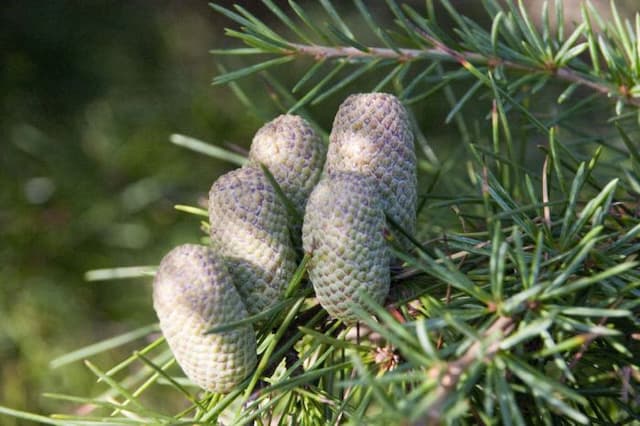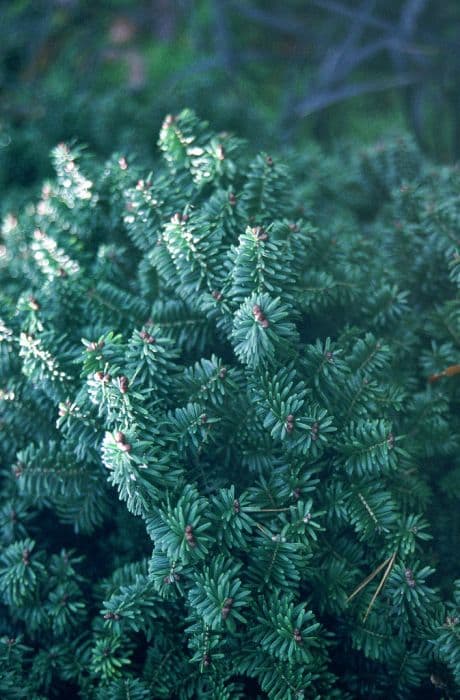Scots Pine Pinus sylvestris (Aurea Group) 'Aurea'

ABOUT
The plant commonly known as Scots pine 'Aurea' is a conifer with a distinct golden-yellow foliage display, especially vibrant during the new growth in spring. As time progresses into summer, the needles take on a more muted, yet still quite pronounced, gold-green hue that can add a warm tone to the landscape. The crown shape is often pyramidal when the plant is young, becoming more rounded with age, but these changes are subtle and do not suggest the actual size of the plant. The needles are arranged in pairs, adding a pleasing texture to the overall appearance. They are also relatively stiff and can prick when handled. During the colder months, 'Aurea' will generally retain its needles, which may darken slightly but typically remain a feature in the winter garden. Cones may be present on the plant, but their color, size, and abundance are not specified here. Overall, the Scots pine 'Aurea' is mainly prized for its striking and colorful foliage which helps it stand out as a specimen in a garden setting without touching on the specifics of its dimensions.
About this plant
 Names
NamesFamily
Pinaceae.
Synonyms
Scots Pine 'Aurea', Golden Scots Pine.
Common names
Pinus sylvestris 'Aurea'.
 Toxicity
ToxicityTo humans
Scots pine is generally not considered toxic to humans. However, as with many plants, individual allergies or sensitivities might exist, and ingesting large quantities of plant material, particularly the needles or sap, could potentially cause digestive upset or irritation to the mouth and throat. There is no well-documented evidence of systemic poisoning from Scots pine in humans following ingestion.
To pets
Scots pine is also not commonly known to be toxic to pets. However, ingestion of pine needles can be harmful to some pets, particularly if they ingest a large amount. The needles can cause gastrointestinal irritation, vomiting, or diarrhea. They can also be a physical hazard due to their sharp, pointed ends, potentially causing punctures or blockages in the digestive tract.
 Characteristics
CharacteristicsLife cycle
Perennials
Foliage type
Evergreen
Color of leaves
Yellow-green
Height
20-60 feet [6-18 meters]
Spread
20-40 feet [6-12 meters]
Plant type
Tree
Hardiness zones
3-7
Native area
Europe
Benefits
 General Benefits
General Benefits- Ornamental Appeal: 'Aurea' is known for its distinctive golden-yellow foliage that adds vibrant color to landscapes.
- Low Maintenance: As a hardy conifer, it requires minimal care once established, making it suitable for gardeners of all skill levels.
- Wildlife Habitat: Provides shelter and nesting sites for birds, as well as food in the form of seeds for various wildlife.
- Soil Stabilization: The extensive root system helps prevent soil erosion, particularly in sandy or unstable soils.
- Privacy Screen: Dense foliage makes it an ideal plant for creating a natural privacy screen or hedge.
- Windbreak: Can be planted in rows to reduce wind speed, protect plants, and provide shelter for wildlife.
- Shade Provider: Grows into a large tree that offers shade in gardens, parks, and recreational areas.
- Seasonal Interest: Retains its color year-round, offering aesthetic appeal even in the winter months.
- Durable Wood: The timber is valued for its durability and is used in construction, carpentry, and furniture making.
- Cultural Significance: Many cultures value pine trees for their symbolic meanings such as longevity, resilience, and peace.
 Medical Properties
Medical PropertiesThis plant is not used for medical purposes.
 Air-purifying Qualities
Air-purifying QualitiesThis plant is not specifically known for air purifying qualities.
 Other Uses
Other Uses- The Scots Pine 'Aurea' needles can be used as natural mulch in garden beds, helping to retain soil moisture and suppress weeds while adding an aesthetic golden hue to the landscape.
- Wood from the Scots Pine 'Aurea' can be used in the construction of furniture, particularly rustic pieces, where the wood's unique coloration can be showcased.
- The strong, resinous scent from the Scots Pine 'Aurea' can be harnessed by placing cut branches indoors, creating a natural air freshener that imparts a forest-like aroma.
- Due to its striking golden color, branches or cones from the Scots Pine 'Aurea' can be integrated into floral arrangements or wreaths, especially during the fall and winter seasons.
- The resin extracted from Scots Pine 'Aurea' can be used to make turpentine, a solvent commonly used in the paint and varnish industry.
- Scots Pine 'Aurea' is sometimes used in the manufacture of paper products, providing cellulose fibers that contribute to the paper's strength and quality.
- The pitch from the Scots Pine 'Aurea' can be used in traditional waterproofing methods, such as sealing the seams of wooden boats or containers.
- Fallen cones from the Scots Pine 'Aurea' can be gathered and used as kindling for fires due to their high resin content, which makes them burn hot and fast.
- Wood chips or shavings from the Scots Pine 'Aurea' can be utilized as bedding for small animals, offering a natural and absorbent material for habitats.
- The Scots Pine 'Aurea' can be used in bonsai cultivation, particularly valued for its golden needle color that adds an unusual hue to the traditional art form.
Interesting Facts
 Feng Shui
Feng ShuiScots Pine is not used in Feng Shui practice.
 Zodiac Sign Compitability
Zodiac Sign CompitabilityScots Pine is not used in astrology practice.
 Plant Symbolism
Plant Symbolism- Resilience: Scots Pine is known for its hardiness and ability to thrive in poor soil conditions, symbolizing the ability to endure and overcome adversity.
- Longevity: As a species that can live for hundreds of years, Scots Pine represents longevity and eternal life.
- Protection: In folklore, pine trees were believed to ward off evil spirits, symbolizing protection and safety.
- Wisdom: Due to its old age and statuesque presence, the Scots Pine is often associated with wisdom and knowledge.
- Peace: Pine branches are traditionally used to signify peace, and pine cones have been symbols of enlightenment and spiritual growth.
 Water
WaterThe Scots Pine 'Aurea' prefers to be watered deeply and infrequently, mimicking natural rainfall patterns. During the first year after planting, water it every 7-10 days with approximately 1-2 gallons, depending on the weather conditions, ensuring it establishes a strong root system. After establishment, the watering frequency can be reduced, and the tree will typically rely on natural precipitation; however, during extended dry periods, additional watering every 2-4 weeks may be beneficial. Always check the soil moisture before watering, as overwatering can lead to root rot.
 Light
LightScots Pine 'Aurea' thrives best in full sun conditions, where it can receive at least six hours of direct sunlight each day. Ideally, position it in a spot that is unobstructed by buildings or other trees to ensure it gets consistent sunlight throughout the day. This variety of pine does not tolerate shade well and will develop optimally in a location with maximum light exposure.
 Temperature
TemperatureScots Pine 'Aurea' is hardy and can withstand a range of temperatures, typically between -40 to 70 degrees Fahrenheit. However, it performs best in areas with cooler climates and can struggle in locations where the summer temperatures frequently exceed 70 degrees Fahrenheit. The ideal temperature range for this pine is between 30 and 60 degrees Fahrenheit, where it can grow without heat stress.
 Pruning
PruningPruning Scots Pine 'Aurea' is generally done to remove dead or diseased branches and to maintain a desired shape or size. The best time for pruning is late winter to early spring before new growth starts. Prune sparingly, as pines do not require regular pruning, and avoid cutting into the older wood, which may not produce new growth. Structural pruning may be done every 3-4 years or as needed.
 Cleaning
CleaningNot needed
 Soil
SoilScots Pine 'Aurea' thrives in well-draining, acidic to neutral soil with pH between 5.5 and 7. A mix of sand, peat, and pine bark in equal parts suits it best, ensuring good aeration and moisture retention for optimal growth.
 Repotting
RepottingScots Pine 'Aurea' typically doesn't need frequent repotting; do it every 2 to 3 years. Since it grows slowly, repotting is necessary only when the pine has outgrown its container or the soil is exhausted.
 Humidity & Misting
Humidity & MistingScots Pine 'Aurea' tolerates a wide range of humidity levels but prefers average atmospheric humidity. It does well outdoors where it receives natural rainfall and air flow, without the need for specific humidity adjustments.
 Suitable locations
Suitable locationsIndoor
Place by a sunny window, minimal watering.
Outdoor
Full sun, well-drained soil, water sparingly.
Hardiness zone
3-7 USDA
 Life cycle
Life cycleThe life of Pinus sylvestris 'Aurea', commonly known as the Scots pine 'Aurea', begins with seed germination, where the seed requires a period of cold stratification to break dormancy. Upon germination, the seedling goes through a juvenile phase, establishing a tap root and beginning to grow needle-like leaves characteristic of the species. The tree then enters a long vegetative growth phase, maturing over several years and developing a distinctive golden-yellow foliage color in full sun, which is a trait of the 'Aurea' cultivar. As an adult, it starts to produce both male and female cones, with the male cones releasing pollen that is wind-dispersed to pollinate female cones. After pollination and fertilization, female cones develop seeds over a period of time, and once mature, the cones open to release the seeds for dispersal. Finally, the Scots pine 'Aurea' reaches maturity, continuing the cycle by producing its own seeds, and with proper conditions, these seeds will germinate to start the cycle anew, with the plant having a lifespan that can exceed hundreds of years in ideal conditions.
 Propogation
PropogationPropogation time
Spring to early summer
The most popular method for propagating Pinus sylvestris 'Aurea', commonly known as Scots Pine, is by seed. Seeds should be collected from cones that have started to open naturally, which usually occurs in the autumn. Once collected, the seeds require cold stratification for a period of 60-90 days to break dormancy before they can germinate; this is done by placing the seeds in a moist substrate within a refrigerator set to 34-40 degrees Fahrenheit (1-4 degrees Celsius). After stratification, seeds are sown shallowly in a well-draining seed starting mix and kept under conditions conducive to germination, which may include a general temperature range of 65-70 degrees Fahrenheit (18-21 degrees Celsius), and consistent moisture. Seedlings are typically ready to be transplanted after the development of a strong root system and a few sets of true leaves.









